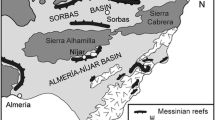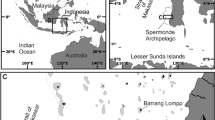Abstract
Sand aprons are located in the back-reef area of atolls and carbonate platforms and form transport pathways of reef-derived sediment into adjacent lagoons and platform interiors. Though there are studies focusing on sand apron sediment dynamics, the knowledge of Holocene sand apron evolution is limited, because hardly any subsurface data are available. In the current model, antecedent topography, i.e., the elevation of the underlying Pleistocene karst surface and platform area are major factors controlling Holocene sand apron development. Because data on marginal reef thickness in Holocene atolls and carbonate platforms are limited, maximum lagoon depth was also used as proxy for the depth to the underlying Pleistocene surface. Sand apron proportions of 122 atolls and carbonate platforms from the Atlantic, Indian and Pacific Oceans were quantified and correlated to maximum lagoon depth, total platform area and marginal reef thickness, when available. Analyses show significant correlations between sand apron proportions and both maximum lagoon depth (r = −0.420; p = 0.000) and total platform area (r = −0.226; p = 0.012). There is no statistically significant correlation (r = −0.364; p = 0.165) between sand apron proportions and depth to Pleistocene surface at platform margins. It is assumed that the lack in correlation can be explained by the limited data set of 16 atolls. Principal component analyses might allow the separation of Atlantic (Caribbean) from Indo-Pacific atolls, which probably arise from spatial and regional variations in sea-level history, i.e., in the Atlantic (transgressive) and Indo-Pacific region (transgressive–regressive), but more subsurface data are necessary to confirm the interpretation. In general, Holocene sand apron formation started when marginal reefs approached relative sea level some 6–3 kyrs BP. Because accommodation space became limited, depositional systems of sand aprons prograded toward the lagoon. Estimated sedimentation rate data of atoll lagoons show that the accumulation of sand aprons is up to three times higher than lagoonal background sedimentation and therefore suited to fill lagoonal accommodation space and create “filled buckets” in small and intermediately sized platforms (up to hundreds of km2 size), even during times of high-amplitude sea-level fluctuations of an icehouse world. Although we postulate an application of the antecedent topography model to Holocene sand apron development, further factors controlling reef development such as hydrodynamics and carbonate production still influence sand apron development and pattern. This study shows the need for further work and knowledge of the subsurface of carbonate platforms and reef sand aprons, which is still limited. Collectively, hydrodynamic (waves, tides and currents), biologic (carbonate production and distribution of organisms) as well as geomorphological (present-day and antecedent topography) factors should be combined, when generating new models for sand apron development to better understand sand apron history in the geologic past.






Similar content being viewed by others
References
Adey WH (1978) Coral reef morphogenesis: a multidimensional model. Science 202:831–837. doi:10.1126/science.202.4370.831
Burne R (1991) Carbonate sediment budgets and coastal management in South Pacific Island nations. Workshop Coast Process S Pac Island Nations SOPAC Technical Bulletin 7:45–53
Camoin GF, Colonna M, Montaggioni LF, Casanova J, Faure G, Thomassin BA (1997) Holocene sea level changes and reef development in southwestern Indian Ocean. Coral Reefs 16:247–259. doi:10.1007/s003380050080
Camoin GF, Ebren P, Eisenhauer A, Bard E, Faure G (2001) A 300,000-year coral reef record of sea level changes, Mururoa Atoll (Tuamotu archipelago, French Polynesia). Palaeogeogr Palaeoclimatol Palaeoecol 175:325–341
Camoin G, Montaggioni LF, Braithwaite CJR (2004) Late glacial to postglacial sea levels in the Western Indian Ocean. Mar Geol 206:119–146. doi:10.1016/j.margeo.2004.02.003
Davies PJ, Hopley D (1983) Growth fabrics and growth rates of Holocene reefs in the Great Barrier Reef. BMR J Australian Geol Geophys 8:237–252
Emery KO, Tracey JL, Ladd HS (1954) Geology of Bikini and nearby atolls. US Geological Survey Professional Paper 260-A:1–265
Gischler E (2003) Holocene lagoonal development in the isolated carbonate platforms off Belize. Sed Geol 159:113–132. doi:10.1016/S0037-0738(03)00098-8
Gischler E (2015) Quaternary reef response to sea level and environmental change in the western Atlantic. Sedimentology 62:429–465. doi:10.1111/sed.12174
Gischler E, Hudson JH (1998) Holocene development of three isolated carbonate platforms, Belize, Central America. Mar Geol 144:333–347
Gischler E, Hudson JH (2004) Holocene development of the Belize barrier reef. Sed Geol 164:223–236
Gischler E, Hudson JH, Pisera A (2008) Late Quaternary reef growth and sea level in the Maldives (Indian Ocean). Mar Geol 250:104–113. doi:10.1016/j.margeo.2008.01.004
Grossman EE, Fletcher CH (2004) Holocene reef development where wave energy reduces accommodation space, Kailua Bay, Windward Oahu, Hawaii, USA. J Sediment Res 74:49–63. doi:10.1306/070203740049
Hammer Ø, Harper DAT, Paul DR (2001) PAST: Paleontological Statistics Software Package for education and data analysis. Palaeontologica Electronica 4:4–9, 178 kb
Harris DL, Vila-Concejo A, De Carli EV, Webster JM (2011) Geomorphology and morphodynamics of a sand apron, One Tree reef, southern Great Barrier Reef. Proceedings of the 11th International Coastal Symposium, Journal of Coastal Research SI 64 760–764
Harris DL, Vila-Concejo A, Webster JM (2014) Geomorphology and sediment transport on a submerged back-reef sand apron: one Tree Reef, Great Barrier Reef. Geomorphology 222:132–142. doi:10.1016/j.geomorph.2014.03.015
Hopley D, Smithers S, Parnell K (2007) The Geomorphology of the Great Barrier Reef, development, diversity and change. Cambridge University Press
Isaack A (2013) Rezente Sedimentfazies der Dry Tortugas, Südflorida, USA. Unpublished M.Sc. thesis, Goethe Universität Frankfurt
Kench PS (1997) Currents of removal analysis of carbonate sediments. Proceedings of the 8th International Coral Reef Symposium, Panama 1:503–508
Kench PS (1998a) Physical controls on development of lagoon sand deposits and lagoon infilling in an Indian Ocean atoll. J Coastal Res 14:1014–1024
Kench PS (1998b) A currents of removal approach for interpreting carbonate sedimentary processes. Mar Geol 145:197–323
Kench PS, Smithers SG, McLean RF, Nichol SL (2009) Holocene reef growth in the Maldives: evidence of a mid-Holocene sea level highstand in the central Indian Ocean. Geology 37:455–458. doi:10.1130/G25590A.1
Klostermann L, Gischler E (2015) Holocene sedimentary evolution of a mid-ocean atoll lagoon, Maldives, Indian Ocean. Int J Earth Sci 104:289–307. doi:10.1007/s00531-014-1068-8
Ladd HS, Schlanger SO (1960) Drilling Operations on Eniwetok Atoll. US Geological Survey Professional Paper 260-Y:863–899
Lewis SE, Wüst RAJ, Webster JM, Shields GA (2008) Mid-late Holocene sea-level variability in eastern Australia. Terra Nova 20:74–81. doi:10.1111/j.1365-3121.2007.00789.x
Lighty RG, Macintyre IG, Stukenrath R (1982) Acropora palmata reef framework: a reliable indicator of sea level in the Western Atlantic for the past 10,000 years. Coral Reefs 1:125–130
Macintyre IG, Burke RB, Stuckenrath R (1977) Thickest recorded Holocene reef section, Isla Pérez core hole, Alacran Reef, Mexico. Geology 5:749–754
Macintyre IG, Graus R, Reinthal PN, Littler MM, Littler DS (1987) The barrier reef sediment apron: tobacco Reef, Belize. Coral Reefs 6:1–12. doi:10.1007/BF00302206
Marshall JF, Davies PJ (1982) Internal structure and Holocene evolution of One Tree Reef, southern Great Barrier Reef. Coral Reefs 1:21–28. doi:10.1007/BF00286536
Marshall JF, Jacobsen G (1985) Holocene growth of a mid-Pacific atoll: Tarawa, Kiribati. Coral Reefs 4:11–17
Montaggioni LF (1988) Holocene reef growth history in mid-plate high volcanic islands. Proceedings of the 6th International Coral Reef Symposium Townsville, Australia 3:455-460
Montaggioni LF (2005) History of Indo-Pacific reef systems since the last glaciation: development patterns and controlling factors. Earth Sci Rev 71:1–75. doi:10.1016/j.earscirev.2005.01.002
O’Leary MJ, Perry CT, Beavington-Penney SJ, Turner JR (2009) The significant role of sediment bio-retexturing within a contemporary carbonate platform system: implications for carbonate microfacies development. Sed Geol 219:169–179. doi:10.1016/j.sedgeo.2009.05.005
Perry CT, Kench PS, Smithers SG, Yamano H, O’Leary M, Gulliver P (2013) Time scales and modes of reef lagoon infilling in the Maldives and controls on the onset of reef island formation. Geology 41:1111–1114. doi:10.1130/G34690.1
Pirazzoli PA, Montaggioni LF (1986) Late Holocene sea level changes in the Northwest Tuamotu Islands, French Polynesia. Quatern Res 25:350–368. doi:10.1016/0033-5894(86)90006-2
Purdy EG (1974) Reef configurations: Cause and effect, in: Laporte LF (ed) Reefs in time and space, SEPM Special Publication 18:9-76
Purdy EG, Gischler E (2005) The transient nature of the empty bucket model of reef sedimentation. Sed Geol 175:35–47. doi:10.1016/j.sedgeo.2005.01.007
Purdy EG, Winterer EL (2001) Origin of atoll lagoons. GSA. Bulletin 113:837–854
Rankey EC, Garza-Peréz JR (2012) Seascape metrics of shelf-margin reef and reef sand aprons of Holocene carbonate platforms. J Sediment Res 82:53–71. doi:10.2110/jsr.2012.7
Rankey EC, Reeder SL, Garza-Peréz JR (2011) Controls on links between geomorphology and surface sedimentological variability: Aitutaki and Maupiti atolls, South Pacific Ocean. J Sediment Res 81:885–900. doi:10.2110/jsr.2011.73
Rashid R, Eisenhauer A, Stocchi P, Liebetrau V, Fietzke J, Rüggeberg A, Dullo WC (2014) Constraining mid to late Holocene relative sea level change in the southern equatorial Pacific Ocean relative to the Society Islands. Geochemistry Geophysics Geosystems, French Polynesia. doi:10.1002/2014GC005272
Schlager W (1993) Accommodation and supply—a dual control on stratigraphic sequences. Sed Geol 86:111–136
Smithers SG, Woodroffe CD, McLean RF, Wallensky EP (1994) Lagoonal sedimentation in the Cocos (Keeling) Islands, Indian Ocean. In: Proceedings of the 7th International Coral Reef Symposium 1:273–288
Stoddart DR (1969) Ecology and morphology of recent coral reefs. Biol Rev 44:433–498
Toscano M, Macintyre IG (2003) Corrected western Atlantic sea-level curve for the last 11,000 years based on calibrated 14C dates from Acropora palmata framework and intertidal mangrove peat. Coral Reefs 22:257–270
Tudhope AW (1989) Shallowing-upwards sedimentation in a coral reef lagoon, Great Barrier Reef of Australia. J Sediment Petrol 59:1036–1051
Vila-Concejo A, Harris DL, Webster JM, Power HE (2013) Coral reef sediment dynamics: evidence of sand apron evolution on a daily and decadal scale. In: Conley DC, Masselink G, Russel PE, O’Hare TJ (eds) Proceedings Coastal Research, SI 65:606–611. doi:10.2112/SI65-103.1
Wasserman HN, Rankey EC (2014) Physical oceanographic influences on sedimentology of reef sand aprons: Holocene of Aranuka Atoll (Kiribati), Equatorial Pacific. J Sediment Res 84:586–604. doi:10.2110/jsr.2014.50
Webster JM (1999) The response of coral reefs to sea level change: evidence from the Ryukyu Islands and the Great Barrier Reef. Unpublished PhD thesis, University of Sydney
Woodroffe CD (2005) Late quaternary sea level highstands in the central and eastern Indian Ocean: a review. Global Planet Change 49:121–138. doi:10.1016/j.gloplacha.2005.06.002
Woodroffe CD, Biribo N (2011) Atolls. In: Hopley D (ed) Encyclopedia of modern coral reefs, structure, form and process. Springer, Berlin, pp 1–21. doi:10.1016/j.margeo.2013.12.006
Woodroffe CD, Webster JM (2014) Coral reefs and sea-level change. Mar Geol 352:248–267. doi:10.1016/j.margeo.2013.12.006
Woodroffe CD, McLean RF, Wallensky E (1994) Geomorphology of the Cocos (Keeling) Islands. Atoll Res Bull 402:1–33
Zinke J, Reijmer JJG, Thomassin BA, Dullo WC, Grootes PM, Erlenkeuser H (2001) Postglacial flooding history of Mayotte lagoon (Comoro archipelago, southwest Indian Ocean). Mar Geol 194:181–196. doi:10.1016/S0025-3227(02)00705-3
Acknowledgments
We thank the Alfons and Gertrud Kassel-Stiftung for financial support (fellowship to AI). The constructive criticisms of Erdal Koşun (Antalya) and an anonymous journal reviewer helped to improve this publication and are gratefully acknowledged.
Author information
Authors and Affiliations
Corresponding author
Rights and permissions
About this article
Cite this article
Isaack, A., Gischler, E. The significance of sand aprons in Holocene atolls and carbonate platforms. Carbonates Evaporites 32, 13–25 (2017). https://doi.org/10.1007/s13146-015-0268-z
Accepted:
Published:
Issue Date:
DOI: https://doi.org/10.1007/s13146-015-0268-z




